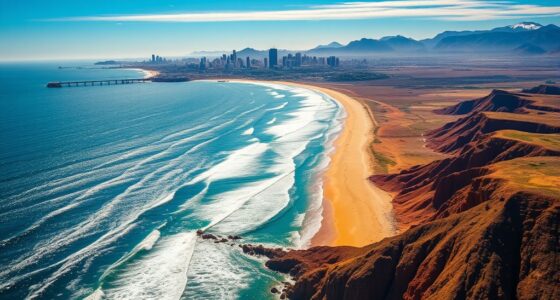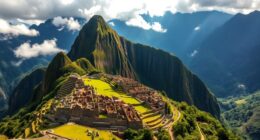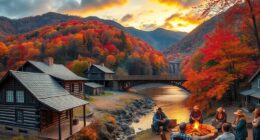Discover the rich history and vibrant culture of California and Nevada, where indigenous tribes like the Miwok and Paiute laid deep roots long before Europeans arrived. European contact, missions, and the Gold Rush transformed these regions into bustling hubs of growth, diversity, and innovation. Today, they showcase iconic landmarks, celebrate heritage through festivals, and thrive with modern attractions. Keep exploring to uncover the fascinating stories behind these dynamic states and their ongoing cultural evolution.
Key Takeaways
- Indigenous tribes such as Miwok, Paiute, and Washoe developed rich traditions, land connections, and tools before European contact.
- European explorers introduced new technologies, religions, and governance, transforming native societies during the mission era and state formation.
- The Gold Rush and silver discoveries fueled rapid economic growth, town development, and statehood in California and Nevada.
- Both states celebrate diverse cultural heritages through festivals, museums, and preservation efforts honoring Native, immigrant, and historical communities.
- Iconic landmarks, festivals, and social movements continue to shape California and Nevada’s cultural identity today.
Native American Roots and Early Inhabitants

Before European explorers arrived, California and Nevada were home to diverse Native American tribes that shaped the land’s history and culture. In California, tribes like the Miwok, Maidu, and Nisenan thrived, developing rich traditions, languages, and hunting practices suited to their environments. Nevada’s landscape was inhabited by the Paiute, Shoshone, and Washoe tribes, each with unique ways of sustaining themselves through fishing, gathering, and hunting. These groups established complex social structures and spiritual beliefs connected to the land. They built lasting settlements, crafted tools, and passed down stories that explained their origins and environment. Their deep connection to the land created a vibrant cultural fabric that influenced the region long before European contact. Additionally, many tribes utilized indigenous tools crafted from locally available materials to support their daily lives and survival.
European Contact, Mission Era, and State Formation
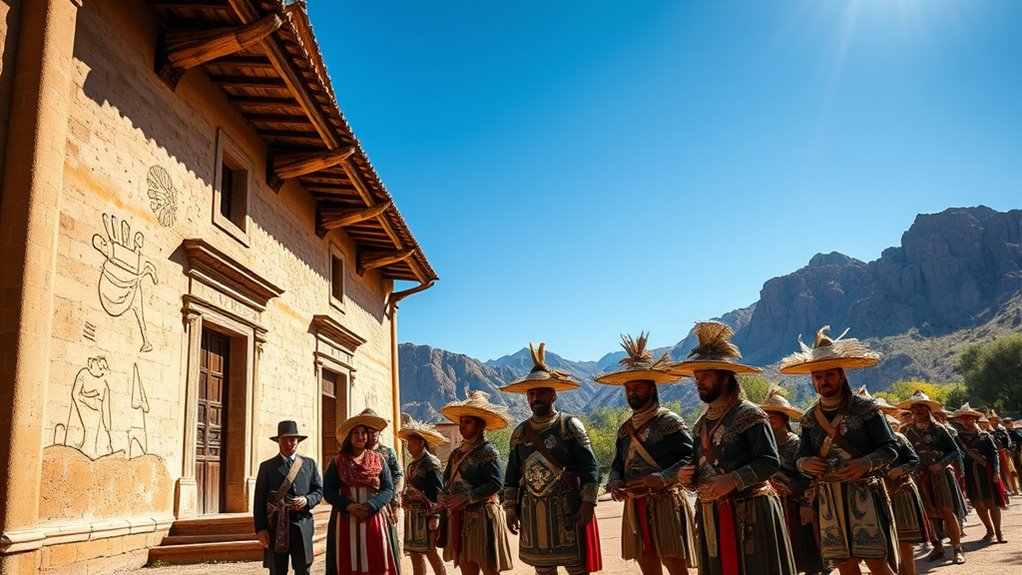
How did European contact transform California and Nevada? European explorers and settlers brought new technologies, religions, and governance, drastically reshaping native societies. The mission era in California began in 1769 with the Spanish establishing religious outposts to convert indigenous peoples, often disrupting their traditional ways of life. In Nevada, Spanish and Mexican influences introduced cattle grazing and land use practices that persisted into American control. Following Mexico’s independence, control shifted to Mexico until the 1848 Treaty of Guadalupe Hidalgo, which ceded California and Nevada to the U.S. The subsequent California Gold Rush in 1848 accelerated settlement, leading to statehood in 1850. This period marked a progression from indigenous autonomy to colonial and territorial governance, setting the foundation for California and Nevada’s modern states. The introduction of best beaches and tourism infrastructure further transformed the regional economies and cultural identities during this era.
The Gold Rush and Economic Transformation
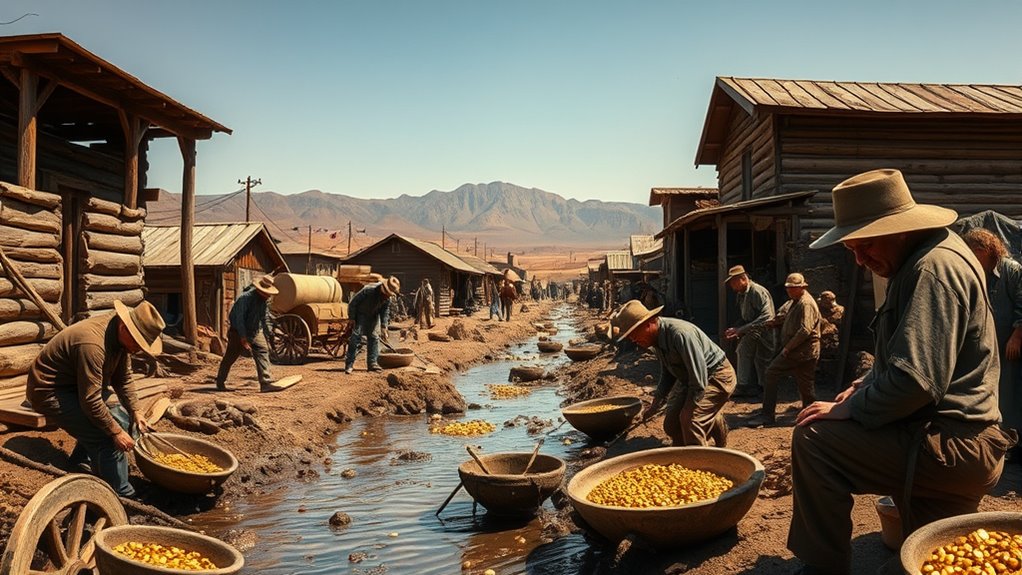
When gold was discovered, it triggered a sudden boom that brought thousands of settlers to California and Nevada. This influx caused rapid population growth and helped the regions develop economically. As a result, both states began diversifying their economies beyond mining, setting the stage for long-term prosperity. The development of crafting cake pops and other confectionery arts reflects the broader trends of innovation and cultural adaptation that emerged as these states transitioned from resource-based economies to diverse cultural hubs.
Gold Discovery Sparks Boom
The discovery of gold in 1848 transformed California from a sparsely populated region into a bustling hub of activity and opportunity. You witness a rapid influx of prospectors, entrepreneurs, and settlers keen to strike it rich. Towns spring up overnight, and infrastructure develops swiftly to support this new population. The economy shifts from sparse agricultural and Native American activities to mining and trade. You see a surge in commerce, transportation routes, and services catering to newcomers. This boom attracts diverse groups, fueling cultural exchange and regional growth. The gold rush’s ripple effects extend beyond California, influencing national economic policies. The transformation is so profound that California quickly advances toward statehood, fundamentally altering its social and economic landscape.
- Rapid town development and infrastructure growth
- Diverse immigrant communities arriving
- Expansion of transportation networks
- Growth of banking and commerce
- Shift from subsistence to market economy
Population Surge and Growth
The discovery of gold in 1848 ignited a massive population surge across California, transforming it from a quiet frontier into a bustling frontier of opportunity. You witness thousands of prospectors, settlers, and entrepreneurs rushing in, enthusiastic to strike it rich. Towns sprout overnight, and new roads and ports develop to support this influx. This rapid growth fuels economic transformation, attracting diverse groups from around the world. As more people arrive, California’s cities expand and its economy diversifies beyond gold. You see farms, businesses, and industries emerge to sustain the growing population. The population boom also accelerates infrastructure development, laying the foundation for California’s future as a major economic hub. This surge of people permanently reshapes California’s social, cultural, and economic landscape. Additionally, the influx of new residents leads to a population surge that continues to influence the state’s growth trajectory.
Economic Diversification Begins
As the Gold Rush transformed California’s landscape, it also sparked the beginning of economic diversification beyond mining. You start to see growth in other sectors as settlers and entrepreneurs recognize new opportunities. This shift leads to the development of agriculture, trade, and manufacturing, which support the expanding population. The construction of the Transcontinental Railroad plays a pivotal role by connecting California to eastern markets, enabling faster movement of goods and people. Additionally, tourism begins to emerge as an essential industry, driven by the state’s natural beauty and landmarks. These changes set the foundation for California’s economic future, turning it into a multi-faceted economic hub. Chia seeds and other health foods begin to gain popularity among health-conscious residents, reflecting a broader trend toward diverse and innovative industries.
Nevada’s Mining Boom and Statehood
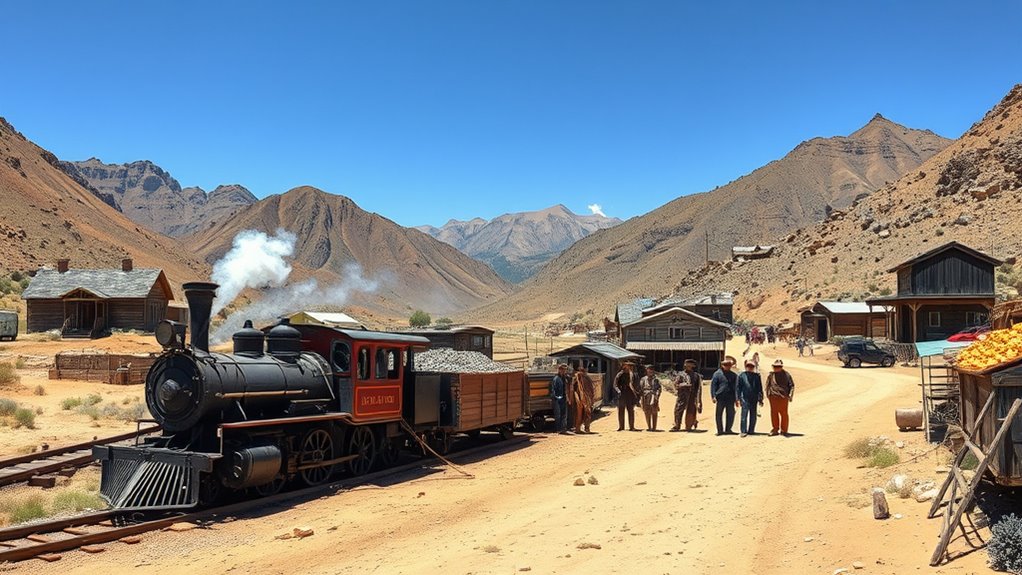
Nevada’s mining boom played a pivotal role in shaping the state’s path to statehood, fueling economic growth and attracting a wave of settlers. The discovery of silver at the Comstock Lode in 1859 transformed Nevada into a key mining hub. This influx of prospectors and entrepreneurs boosted the economy and increased territorial population. The need for governance and infrastructure led to Nevada becoming the 36th state in 1864, earning the nickname “Battle Born.” Mining towns rapidly developed, shaping Nevada’s identity. Below is a snapshot of key aspects during this period:
| Aspect | Impact | Notable Event |
|---|---|---|
| Silver Discovery | Economic growth, expansion of settlements | Comstock Lode, 1859 |
| Population Growth | Rapid increase, diverse settlers | Mining rushes |
| Statehood | Quick political organization | 1864, Nevada becomes a state |
| Infrastructure | Railroads, towns emerge | Transcontinental Railroad |
| Cultural Shift | Pioneering spirit, frontier life | Mining communities |
Furthermore, the influx of miners and settlers contributed to urban development and the growth of local economies, solidifying Nevada’s place in the expanding American frontier.
Cultural Diversity and Social Movements
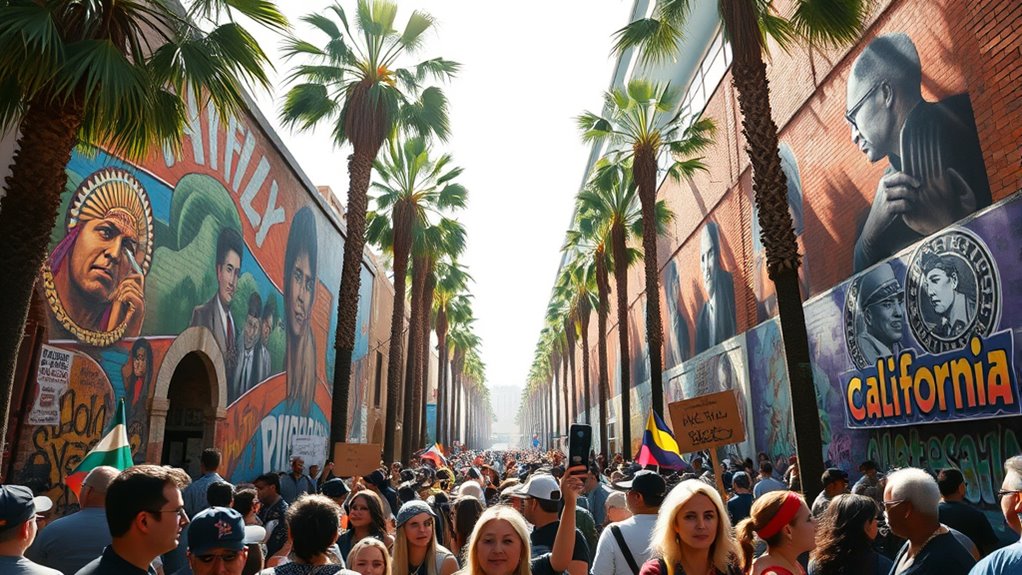
You can see how California and Nevada celebrate their diverse histories through Native American heritage preservation and vibrant cultural festivals. Social movements like civil rights have shaped the states’ communities, inspiring change and activism. By exploring these events and initiatives, you gain a deeper understanding of how culture and activism continue to influence the region today. Additionally, the rich history of Self Watering Plant Pots reflects ongoing innovations in sustainable gardening practices that have become part of the region’s cultural landscape.
Native American Heritage Preservation
How do California and Nevada work to preserve their rich Native American heritage amidst ongoing social and cultural changes? They implement policies supporting tribal sovereignty, establish cultural centers, and fund language revitalization programs. You’ll find reservations actively maintaining traditional practices, ceremonies, and arts. Both states recognize Native history through protected sites and museums, ensuring future generations learn their stories. Efforts also include collaboration with tribes on land management and environmental projects, respecting their deep spiritual connection to the land.
- Tribal heritage sites protected by law
- Language and cultural revival initiatives
- Native-led educational programs
- Inclusion of Native history in state curricula
- Support for traditional arts and practices
Civil Rights Movements
Civil rights movements have played a pivotal role in shaping the social fabric of California and Nevada, challenging discrimination and advocating for equality across diverse communities. In California, the fight for Latino and Asian American rights gained momentum during the Chicano Movement and Asian American activism, pushing for fair employment, education, and representation. Nevada saw Native American communities organize for recognition and better treatment, especially during the 20th century. Both states experienced the broader Civil Rights Movement of the 1960s, which fought segregation and voting rights issues. Activists organized protests, legal challenges, and advocacy campaigns that led to significant policy changes. These movements helped foster greater cultural awareness, inclusion, and social justice, shaping the ongoing pursuit of equality in California and Nevada today. The influence of these social movements continues to inspire contemporary activism and policy reforms.
Cultural Festivals and Events
Cultural festivals and events in California and Nevada celebrate the rich diversity and social movements that have shaped these states. They serve as vibrant reflections of each region’s unique history, heritage, and ongoing struggles for equality. These gatherings often highlight indigenous traditions, immigrant communities, and pivotal social causes. Participating in these events allows you to experience the cultural tapestry firsthand and gain insight into social progress. They foster community, promote understanding, and honor the resilience of marginalized groups. From music and dance to parades and art exhibitions, these festivals create platforms for dialogue and celebration. They also inspire ongoing activism and awareness, ensuring that history’s lessons resonate through contemporary cultural expression. Recognizing the importance of cultural identity helps deepen appreciation for the diverse histories represented in these festivities.
Modern Cultural Landmarks and Tourism Attractions
California and Nevada boast iconic landmarks and vibrant attractions that draw millions of visitors each year. In California, you can explore Yosemite National Park’s stunning granite cliffs, visit the Hollywood Walk of Fame, or enjoy the beaches of Santa Monica. Nevada offers the excitement of Las Vegas, famous for its casinos and entertainment, along with Lake Tahoe’s scenic beauty. These destinations showcase the diverse appeal of both states. Additionally, understanding sleep hygiene can enhance your overall travel experience by helping you rest better during your visits to these lively locations.
Frequently Asked Questions
How Did California and Nevada Influence Native American Populations Historically?
You see that California and Nevada profoundly impacted Native American populations by causing declines through settler conflicts, displacement, and disease. As settlers arrived during events like the Gold Rush, Native tribes faced loss of land, resources, and traditional ways of life. Despite their deep roots in these regions, Native communities experienced disruption and hardship, and today, efforts continue to preserve their cultural heritage and advocate for their rights.
What Role Did Spanish and Mexican Governance Play in Shaping Local Culture?
Spanish and Mexican governance deeply shaped your local culture by introducing new traditions, architecture, and land use practices. You might notice influences in place names, mission-style buildings, and agricultural methods still present today. These governments also impacted social structures and introduced Catholicism, which blended with indigenous beliefs. As a result, the cultural landscape reflects a mix of native and Hispanic elements that continue to influence your community’s identity and customs.
How Did the Development of Railroads Impact Regional Growth and Migration?
Think of the railroad as a giant artery pumping life into the region. You see, it connected towns, making travel faster and easier, which led to a surge of settlers and businesses. You’d notice cities sprouting along the tracks like flowers after rain. The railroad opened up resources, boosted trade, and encouraged migration, transforming isolated areas into bustling hubs of growth and opportunity. It truly shaped the region’s vibrant development.
In What Ways Have Mining Booms Affected Environmental Sustainability?
Mining booms have critically impacted environmental sustainability by causing deforestation, soil erosion, and water pollution. You might notice how mining activities deplete natural resources and disrupt ecosystems, making land less usable for future generations. Mining operations often release hazardous chemicals, harming wildlife and contaminating water supplies. These environmental changes threaten long-term sustainability, making it vital for you to support responsible mining practices and conservation efforts to protect natural landscapes and resources.
How Have Modern Entertainment Industries Shaped Cultural Identities?
You see the glittering neon lights of entertainment industries, shaping cultural identities like a mirror reflecting society’s dreams and values. Hollywood’s storytelling and Nevada’s casinos symbolize glamour, risk, and aspiration. These industries forge community bonds and influence global perceptions, becoming a cultural heartbeat. You’re part of this dynamic, where entertainment isn’t just a pastime but a powerful force that defines who you are and how you see the world around you.
Conclusion
You explore California and Nevada’s rich history, embracing their Native roots, their transformative gold and silver booms, and their vibrant cultural diversity. You witness their evolution from early inhabitants to modern landmarks, from frontier towns to bustling cities. You experience the stories of resilience, innovation, and community that define these states. You celebrate their past, embrace their present, and look forward to their future—continually shaping, continually growing, continually inspiring.




